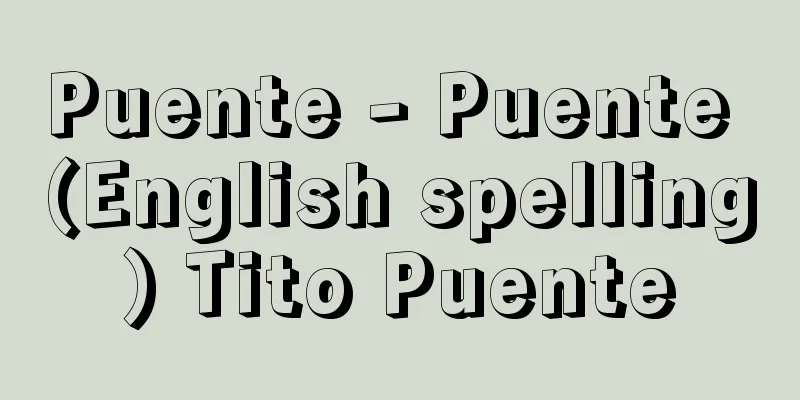Puente - Puente (English spelling) Tito Puente

|
American percussionist (timbales, vibraphone) and big band leader. His real name was Ernest Antonio Puente Jr. "Tito" comes from Ernesto's nickname, Ernestito. He is Puerto Rican, born in East Harlem, New York. He is known as the "Mambo King" and is one of the most respected US Latino (Spanish-speaking people from Central and South America and the Caribbean islands) musicians. He initially wanted to be a dancer, but an injury forced him to give up and he attended the New York School of Music, where he took piano, saxophone, and later drum lessons. He dropped out at age 16 to become a full-time professional musician. From 1941 to 1942, he played drums in the Noro Morales Orchestra, the most popular band of the time. In 1942, he also played timbales in the Machito Orchestra. He enlisted in the military that same year, and as a member of the military band, he played alto saxophone and drums, learning arrangements from other musicians. After his discharge, he studied music theory, orchestration, and conducting at the Juilliard School on the GI Bill (a preferential treatment given to those who had served in the military). After graduating, he worked with the Jose Curbero Orchestra and the Fernando Alvarez Brazilian Band, before becoming the drummer and musical director of the Pupi Campo Orchestra in 1947. While still with the orchestra, he formed his own orchestra, the Piccadilly Boys (later known as Tito Puente and His Orchestra), in 1948. In 1949, he left the Pupi Campo Orchestra to focus on his own orchestra. He made his record debut in 1949 with an initial seven-piece lineup (two trumpets, piano, bass, congas, bongos, and vocals), but by the same year, the lineup had expanded to four trumpets, three trombones, and four saxophones, making it a 16-piece lineup. He attracted many talented musicians, including singer Vincentico Valdés (1919-1995), percussionist Manny Oquendo (1931-2009), pianist Charlie Palmieri (1927-1988), and percussionist Mongo Santamaria (1922-2003), and during the heyday of mambo in New York in the 1950s, he competed in popularity and talent with the band of his childhood friend, vibraphone and guitarist Tito Rodriguez (1923-1972). Many excellent musicians continued to gather in Puente's band, and in the 1960s they played all kinds of songs, from hits from Broadway musicals to Afro-Cuban music, incorporating new musical trends such as pachanga (a style of music created in Cuba in the early 1960s based on the rhythms of Colombian, Dominican and Haitian music), boogaloo (a Latin music that combines elements of rock, rhythm and blues and jazz), and Latin soul music, and also recorded with many singers such as Celia Cruz (1925-2003). In 1962, they recorded "Oje como ba", which became a big hit when covered by Carlos Santana in 1970. In 1979, they came to Japan with the LP (Latin Percussion Company) Jazz Ensemble and held workshops. He continued to work energetically after that, and in 1991, he released his 100th album, commemorating this with the release of the album " The Mambo King". Even after this major milestone, he continued to tour, perform in clubs, and record with three ensembles: Tito Puente and His Orchestra, the Golden Latin Jazz All-Stars, and the Latin Jazz Ensemble, and released a total of 120 albums, including those released after his death. He visited Japan frequently and was widely loved by fans of jazz and Latin American music. [Takuma Azuma] "Takuma Azuma (ed.), Caribbean and Latin America: A Map of Sounds (2002, Ongaku No Tomosha)" ▽ "Steven Loza, Tito Puente and the Making of Latin Music (1999, University of Illinois Press, Urbana)" ▽ "Scott Yanow, Afro-Cuban Jazz (2000, Miller Freeman Books, San Francisco)" ▽ "Ed Morales, Living in Spanglish; The Search for Latino Identity in America (2002, St. Martin Press, New York)" [References] | | |Source: Shogakukan Encyclopedia Nipponica About Encyclopedia Nipponica Information | Legend |
|
アメリカのパーカッション(ティンバレス、ビブラホーン)奏者、ビッグ・バンド・リーダー。本名エルネスト・アントニオ・プエンテ・ジュニアErnest Antonio Puente Jr.。「ティト」はエルネストの愛称であるエルネスティートからきている。ニューヨークのイースト・ハーレムに生まれたプエルトリカン。「マンボ・キング」として親しまれ、もっとも尊敬されたUSラティーノ(中南米およびカリブ海諸島などのスペイン語圏出身者)のミュージシャン。 当初、ダンサーを志していたがけがであきらめ、ニューヨーク・スクール・オブ・ミュージックでピアノ、サックスのレッスンを受け、後にドラムを学ぶ。16歳で学校を中退し、フルタイムのプロ・ミュージシャンとなる。1941~1942年、当時もっとも人気の高かったノロ・モラレス楽団でドラムを叩く。1942年にはマチート楽団でティンバレスも担当。同年兵役につき、軍楽隊のメンバーとしてアルト・サックスとドラムを担当し、ほかのミュージシャンからアレンジを学んだ。除隊後、GIビル(兵役経験者に対して支給される優遇措置)でジュリアード音楽学校で音楽理論、オーケストレーション、指揮などについて学ぶ。 卒業後ホセ・クルベーロ楽団、フェルナンド・アルバレス・ブラジリアン・バンドなどを経て、1947年にはプピ・カンポ楽団のドラマー兼音楽監督に就任。同楽団在籍中の1948年に自らの楽団ピカデリー・ボーイズ(後のティト・プエンテ・アンド・ヒズ・オーケストラ)を結成。1949年にプピ・カンポ楽団を辞め、自分の楽団に専念する。当初7人編成(トランペット2、ピアノ、ベース、コンガ、ボンゴ、ボーカル)で1949年にレコード・デビューするが、同年にはトランペット4人、トロンボーン3人、サックス4人と膨れ上がり16人編成になる。彼のもとには歌手ビセンティコ・バルデスVincentico Valdés(1919―1995)、パーカッショニスト、マニー・オーケンドーManny Oquendo(1931―2009)、ピアノ奏者チャーリー・パルミエリCharlie Palmieri(1927―1988)、パーカッショニスト、モンゴ・サンタマリアMongo Santamaria(1922―2003)などの逸材が集まり、1950年代のニューヨークでのマンボ全盛期には幼なじみのビブラホーン、ギター奏者ティト・ロドリゲスTito Rodriguez(1923―1972)の楽団と人気、実力でしのぎを削る。 その後もプエンテの楽団には多くの優れたミュージシャンが集結し、1960年代にはパチャンガ(1960年代初頭にコロンビア、ドミニカ、ハイチ音楽のリズムをもとにキューバでつくられた音楽)、ブーガルー(ロック、リズム・アンド・ブルース、ジャズなどの要素を融合させたラテン音楽)、ラテン・ソウル・ミュージックといった新しい音楽の流行も取り入れながら、ブロードウェー・ミュージカルのヒット曲からアフロ・キューバン音楽まであらゆる曲を演奏し、セリア・クルーズCelia Cruz(1925―2003)など多くの歌手との録音も行う。1962年には「オジェ・コモ・バ」を吹き込む。この曲は1970年にカルロス・サンタナがカバーして大ヒットした。1979年(昭和54)には、LP(ラテン・パーカッション社)ジャズ・アンサンブルで来日し、ワークショップも行う。その後も精力的に活動を続け、1991年にはアルバムが通算100枚目となり、それを記念してアルバム『ザ・マンボ・キング』The Mambo Kingを発表する。この大きな節目の後も、ティト・プエンテ・アンド・ヒズ・オーケストラ、ゴールデン・ラテン・ジャズ・オールスターズ、ラテン・ジャズ・アンサンブルの三つのアンサンブルを中心にツアーやクラブでの演奏、録音を重ね、アルバムは死後に発表されたものを加えると120枚に及ぶ。日本にもたびたび訪れ、ジャズ、ラテンアメリカ音楽のファンに広く親しまれた。 [東 琢磨] 『東琢磨編『カリブ・ラテンアメリカ 音の地図』(2002・音楽之友社)』▽『Steven LozaTito Puente and the Making of Latin Music(1999, University of Illinois Press, Urbana)』▽『Scott YanowAfro-Cuban Jazz(2000, Miller Freeman Books, San Francisco)』▽『Ed MoralesLiving in Spanglish; The Search for Latino Identity in America(2002, St. Martin Press, New York)』 [参照項目] | | |出典 小学館 日本大百科全書(ニッポニカ)日本大百科全書(ニッポニカ)について 情報 | 凡例 |
>>: Fenjiu (Fen wine) - Fenjiu (English spelling) Fenjiu
Recommend
Kamesan Kanjuro - Kamesan Kanjuro
...The original title is "Waka Midori Suehir...
Long
〘noun〙① (adjective) Long in length. In particular,...
Unenga Canal
...The delta on the north bank of the Yangtze Riv...
Meika Uno
Year of death: 14th April 1745 (15th May 1745) Yea...
Kinjumon
…Chinese calligrapher and painter of the mid-Qing...
Okikurage - Okikurage
A jellyfish of the family Oxygeidae, class Scypho...
Italian Merchant - Italian Merchant
…This development unfolded along the trade route ...
Roman de Brut (English spelling) RomandeBrut
…Born in Jersey, he was educated mainly in France...
Pannonii
Pannonia was a Roman province inhabited by the Pa...
Language education - Gengokyoiku (English)
Generally speaking, it refers to mother tongue edu...
Sadataka Ise
Year of death: September 11, 1562 (October 8, 1562...
Anago anago (English spelling) Anagoanago
…This species is considered the most delicious of...
Korean Blacksmith - Karakanuchi
〘Name〙 One of the blacksmiths who served the Great...
Housing problem - housing problem English
Housing is the foundation of human survival and li...
Intermaxillary bone
→Intermaxillary bone Source : Heibonsha Encycloped...









